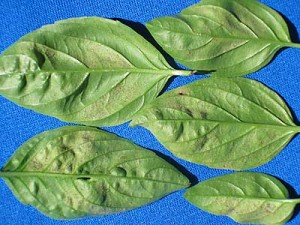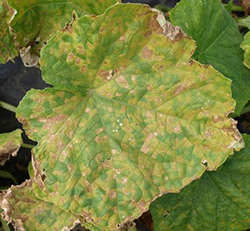Thank you to Margaret Tuttle McGrath with the Long Island Horticultural Research & Extension Center for providing the following content and opportunity!

Occurrence of two important diseases is being monitored to be able to inform farmers, so they know when preventive fungicide applications are warranted, and to increase knowledge about these diseases. Occurrence of these diseases vary yearly. Extension plant pathologists, who have been maintaining sentinel plots and checking farmers’ crops, recognizing that gardener citizen scientists could be a valuable addition to the monitoring effort, are now seeking gardeners to help by looking for downy mildew on their garden cucurbit and/or basil plants. Knowing how widespread these diseases are in an area is also important, so gardener observations are also valuable even when a report has already been entered for their area. The pathogen causing downy mildew on cucurbits exhibits host specialization, which means different strains occur on different cucurbits. Cucumber is most often affected, but it is valuable to check all cucurbits being grown.

For more information, please see this article on the topic: https://cals.cornell.edu/news/2021/07/meg-mcgrath-battles-pesto-pest-basil-downy-mildew
Thank you very much for considering volunteering to help with the monitoring programs. Your assistance is greatly appreciated! Your observations will be very helpful!
Following is a list of activities for monitoring the downy mildew diseases:
1. Become familiar with downy mildew symptoms.
Cucurbit downy mildew: https://cdm.ipmpipe.org/gardens-and-cdm/
Basil downy mildew: https://basil.agpestmonitor.org/identification/
2. Optional: Sign up for alerts to know when someone else has reported downy mildew near you (can be anywhere in your state or any distance you choose from your planting).
Cucurbit downy mildew: https://cdm.ipmpipe.org/alerts/
Basil downy mildew: https://basil.agpestmonitor.org/alerts/
3. Record date your plants start growing outside.
Include this in your report if you see downy mildew.
4. Look at leaves approximately once a week for symptoms.
5. Take photographs of both the top and bottom side of affected leaf when you think you are seeing downy mildew.
Send to your state pathologist contact (if you have one) or to mtm3@cornell.edu. Morning is the best time to take photographs because pathogen spores are most visible. Different strains of the pathogen affect different cucurbit types, so you may see downy mildew on cucumber but not other cucurbit types you grow. If you grow other cucurbit types in addition to cucumber, continue checking them after you find downy mildew on cucumber.
6. If downy mildew is confirmed, next step is to log a report (state who confirmed via photo) and submit your photo at:
Cucurbit downy mildew: https://cdm.ipmpipe.org/reportingform/
Basil downy mildew: https://basil.agpestmonitor.org/reporting-form/
7. If you do not see symptoms before your plants naturally senesce, please send an email to mtm3@cornell.edu so we know.
Knowledge of where these diseases are not observed is also important. Include date your plants started growing outside and when they died so we know when there was susceptible plant tissue in your garden. Also include your location.
For more information on this project, reach out to:
*****************************
Margaret Tuttle McGrath
Plant Pathology and Plant-Microbe Biology Section
School of Integrative Plant Science
Cornell University
Long Island Horticultural Research & Extension Center
3059 Sound Avenue
Riverhead, NY 11901-1098
Phone: 631-727-3595 ext 20
Note: during the pandemic I am best reached by e-mail as I am not in my office to answer phone calls
Fax: 631-727-3611
http://blogs.cornell.edu/livegpath/
https://www.vegetables.cornell.edu/pest-management/disease-factsheets/
http://www.plantpath.cornell.edu/labs/mcgrath/index.html
LIHREC – SERVING LONG ISLAND HORTICULTURE FOR 100 YEARS!
1922-2022